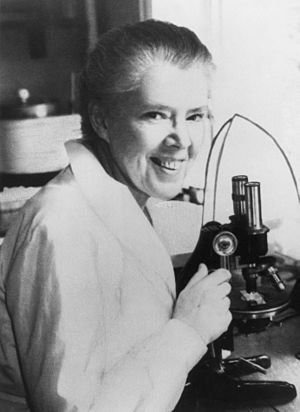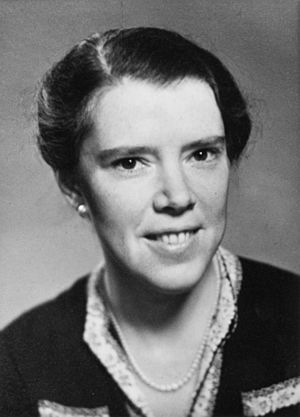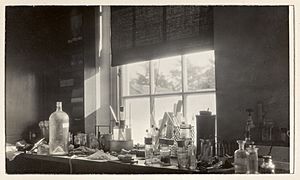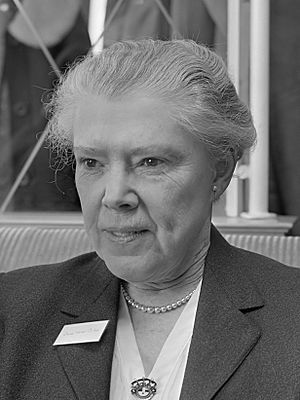Honor Fell facts for kids
Quick facts for kids
Dame
Honor Fell
FRS, DBE
|
|
|---|---|
 |
|
| Born |
Honor Bridget Fell
22 May 1900 Fowthorpe, near Filey, Yorkshire, England
|
| Died | 22 April 1986 (aged 85) Cambridge, England
|
| Alma mater | University of Edinburgh |
| Known for | Directing Strangeways Research Laboratory, developing tissue culture technique |
| Awards | American Academy of Arts and Sciences, Grand Prix Charles-Leopold Mayer (French Academy of Sciences), honorary doctorates at several universities |
| Scientific career | |
| Fields | Zoology, physiology, cell biology |
| Institutions | Strangeways Research Laboratory, University of Cambridge |
| Notable students | Margaret Hurlstone Hardy Fallding |
Dame Honor Bridget Fell (born May 22, 1900 – died April 22, 1986) was a brilliant British scientist. She was a zoologist who made huge strides in understanding how cells and tissues grow outside the body. Her work helped create new ways to study living things in the lab. She was especially known for developing methods in organ culture and tissue culture.
Contents
Early Life and Education
Honor Fell was born on May 22, 1900, in Fowthorpe, near Filey in Yorkshire, England. She was the youngest of nine children. Her mother was a skilled carpenter. From a young age, Honor loved animals, especially her pet ferrets. She even brought her ferret, Janie, to her sister's wedding when she was 13!
Honor went to Wychwood School in North Oxford. This school was special because it focused a lot on science, especially biology. Later, she attended Madras College. In 1918, she began studying zoology at the University of Edinburgh.
Her professor, Francis Albert Eley Crew, suggested she work with Thomas Strangeways. He was a pathologist in Cambridge who was exploring a new field called tissue culture. After graduating in 1922, Honor became a full-time research assistant to Strangeways. She earned her Ph.D. in 1924 and a D.Sc. in 1932.
Leading the Strangeways Research Laboratory
The Strangeways Research Laboratory in Cambridge was a famous place for scientific research. After Thomas Strangeways passed away in 1926, the lab's future was uncertain. But Honor Fell and her colleague F.G. Spear convinced the leaders to keep it open.
In 1928, Honor Fell became the new director of the lab. It was renamed the Strangeways Research Laboratory in honor of its founder. Honor led the lab until 1970. During her time, she continued her own important research on growing tissues and organs outside the body.
Even though the lab didn't always have a lot of money, it became world-famous. Scientists from many different countries came to visit and learn. Honor Fell was a rare example of a woman in a top science leadership role at that time. She strongly supported other women in science, like Australian zoologist Margaret Hurlstone Hardy Fallding. Many people believe Honor's excellent networking and management skills were key to the lab's success.
Retirement and Continued Research
After retiring in 1970, Honor Fell didn't stop working. She became a researcher at the University of Cambridge. There, she focused on understanding rheumatoid arthritis, a disease that affects joints.
In 1979, she returned to the Strangeways Laboratory. She continued her research there until shortly before her death in 1986.
Developing Tissue and Organ Culture Methods
Honor Fell's career started when tissue culture was a very new idea. This method allowed scientists to study living cells outside of an animal's body. It meant they could watch how cells grew and changed in a controlled environment.
Before Honor joined, biologist Ross Harrison began this research in 1907. He did small experiments in 1910. This allowed scientists to see how cells behaved, almost like tiny organs. This new way of studying living cells was very exciting.
One important method Honor worked on was organ culture. This is a great way to study how organized groups of cells, like a tiny piece of an organ, react to different things in their environment. These techniques became a huge part of life science research. They are now a key way scientists study how living things work.
Personal Life
Honor Fell lived alone and never married or had children. She lived close to the laboratory for easy access to her work. She enjoyed going on picnics with friends in the countryside.
While she listed "Travel" as a hobby, most of her trips were for science. She traveled all over the world to attend conferences, work with other scientists, give important lectures, or receive awards. She loved how these trips helped scientists work together. Her ability to encourage teamwork among scientists was very important to the success of the Strangeways Laboratory.
Awards and Recognitions
- 1924: Junior Beit Fellow
- 1927: 4th-year Beit Fellow
- 1928: Senior Beit Fellow
- 1929–70: Director of the Strangeways Research Laboratory
- 1931–43: Messel Research Fellow, Royal Society
- 1943–67: Foulerton Research Fellow, Royal Society
- 1948: Trail Award and medal, Linnaeus Society
- 1953: Elected Fellow, Royal Society of London
- 1955: Elected Fellow, Girton College, Cambridge
- 1957: Elected Foreign Honorary Member, American Academy of Arts and Sciences
- 1959: Awarded Honorary LL.D, University of Edinburgh
- 1963: Awarded Dame Commander of the Order of the British Empire (DBE)
- 1963: Appointed Royal Society Research Professor
- 1964: Awarded Honorary D.Sc, University of Oxford
- 1964: Awarded Honorary Sc.D, Harvard University
- 1965: Awarded the Grand Prix Charles-Leopold Mayer of the French Academy of Sciences
- 1975: Awarded Honorary MD, University of Leiden
- 1977: Appointed, Walker-Ames Professor, University of Washington, Seattle




